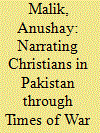| Srl | Item |
| 1 |
ID:
170473


|
|
|
|
|
| Summary/Abstract |
The discussion of Christians in Pakistan usually starts off with them being viewed as a besieged minority without agency which was marginalised further as Pakistan became more ‘Islamic’ through official legislation, particularly under the regime of General Zia ul-Haq in the 1980s. This article attempts to historicise this narrative by focusing on the 1950s and 1960s. It argues that in the early years of Pakistan’s existence, Christians narrated themselves as being important for the very formation of Pakistan and believed that a more equal citizenship was possible, but the environment of political repression under General Ayub Khan, and the war with India in 1965, quickly closed off such possibilities.
|
|
|
|
|
|
|
|
|
|
|
|
|
|
|
|
| 2 |
ID:
160163


|
|
|
|
|
| Summary/Abstract |
In 1968 a popular movement emerged on the streets of Pakistan which toppled the regime of General Muhammad Ayub Khan and ushered in the Pakistan People's Party (PPP). After a decade of military rule this movement was heralded as a turning point in the country's political fortunes. However, the war in 1971, the failure of the PPP to live up to its radical slogans, and Pakistan's eventual return to military rule in 1977 were seen as clear indications of the failure of both the movement and the PPP. This article focuses on the area of Kot Lakhpat in Lahore and the emergence of a worker-led court under Abdur Rehman to argue that this narrative of the failure of the movement does not leave space for local success stories which, while temporary, had an important impact on the role that the working classes imagined for themselves within the state. The Kot Lakhpat movement was part of a longer history of labour politics, and its story challenges the centrality of the PPP and shows how local structures of authority can be formed in response to the greater space for radical action opened up by a wider national resistance movement.
|
|
|
|
|
|
|
|
|
|
|
|
|
|
|
|